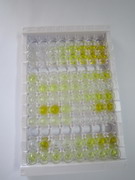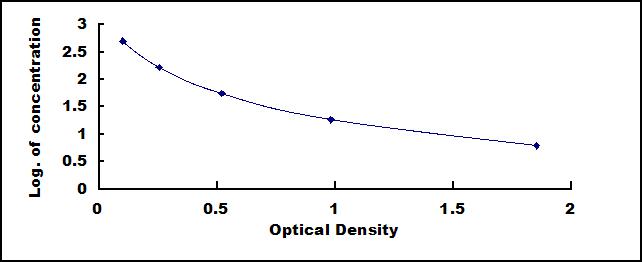Packages (Simulation)

Reagent Preparation

Image (I)
Image (II)
Certificate


ELISA Kit for Thyrotropin Releasing Hormone (TRH)
TRF; Thyrotropin-Releasing Factor; Thyroliberin; Protirelin; Pro-tirelin; Prothyroliberin; TSH-releasing factor
- Product No.CEA839Hu
- Organism SpeciesHomo sapiens (Human) Same name, Different species.
- Sample Typeserum, plasma and other biological fluids
- Test MethodCompetitive Inhibition
- Assay Length2h
- Detection Range6.17-500pg/mL
- SensitivityThe minimum detectable dose of this kit is typically less than 2.94pg/mL.
- DownloadInstruction Manual
- UOM 48T96T 96T*5 96T*10 96T*100
- FOB
US$ 441
US$ 630
US$ 2835
US$ 5355
US$ 44100
For more details, please contact local distributors!
Specificity
This assay has high sensitivity and excellent specificity for detection of Thyrotropin Releasing Hormone (TRH).
No significant cross-reactivity or interference between Thyrotropin Releasing Hormone (TRH) and analogues was observed.
Recovery
Matrices listed below were spiked with certain level of recombinant Thyrotropin Releasing Hormone (TRH) and the recovery rates were calculated by comparing the measured value to the expected amount of Thyrotropin Releasing Hormone (TRH) in samples.
| Matrix | Recovery range (%) | Average(%) |
| serum(n=5) | 81-103 | 91 |
| EDTA plasma(n=5) | 90-97 | 94 |
| heparin plasma(n=5) | 95-104 | 101 |
Precision
Intra-assay Precision (Precision within an assay): 3 samples with low, middle and high level Thyrotropin Releasing Hormone (TRH) were tested 20 times on one plate, respectively.
Inter-assay Precision (Precision between assays): 3 samples with low, middle and high level Thyrotropin Releasing Hormone (TRH) were tested on 3 different plates, 8 replicates in each plate.
CV(%) = SD/meanX100
Intra-Assay: CV<10%
Inter-Assay: CV<12%
Linearity
The linearity of the kit was assayed by testing samples spiked with appropriate concentration of Thyrotropin Releasing Hormone (TRH) and their serial dilutions. The results were demonstrated by the percentage of calculated concentration to the expected.
| Sample | 1:2 | 1:4 | 1:8 | 1:16 |
| serum(n=5) | 79-101% | 97-105% | 94-101% | 84-98% |
| EDTA plasma(n=5) | 85-102% | 79-102% | 82-93% | 81-104% |
| heparin plasma(n=5) | 84-104% | 78-101% | 80-89% | 81-104% |
Stability
The stability of kit is determined by the loss rate of activity. The loss rate of this kit is less than 5% within the expiration date under appropriate storage condition.
To minimize extra influence on the performance, operation procedures and lab conditions, especially room temperature, air humidity, incubator temperature should be strictly controlled. It is also strongly suggested that the whole assay is performed by the same operator from the beginning to the end.
Reagents and materials provided
| Reagents | Quantity | Reagents | Quantity |
| Pre-coated, ready to use 96-well strip plate | 1 | Plate sealer for 96 wells | 4 |
| Standard | 2 | Standard Diluent | 1×20mL |
| Detection Reagent A | 1×120µL | Assay Diluent A | 1×12mL |
| Detection Reagent B | 1×120µL | Assay Diluent B | 1×12mL |
| TMB Substrate | 1×9mL | Stop Solution | 1×6mL |
| Wash Buffer (30 × concentrate) | 1×20mL | Instruction manual | 1 |
Assay procedure summary
1. Prepare all reagents, samples and standards;
2. Add 50µL standard or sample to each well.
And then add 50µL prepared Detection Reagent A immediately.
Shake and mix. Incubate 1 hour at 37°C;
3. Aspirate and wash 3 times;
4. Add 100µL prepared Detection Reagent B. Incubate 30 minutes at 37°C;
5. Aspirate and wash 5 times;
6. Add 90µL Substrate Solution. Incubate 10-20 minutes at 37°C;
7. Add 50µL Stop Solution. Read at 450 nm immediately.
GIVEAWAYS
INCREMENT SERVICES
| Magazine | Citations |
| Plos one | Thyrotropin-Releasing Hormone (TRH) Promotes Wound Re-Epithelialisation in Frog and Human Skin PubMed: PMC3759422 |
| Analyst | Ultrasensitive detection of thyrotropin-releasing hormone based on azo coupling and surface-enhanced resonance Raman spectroscopy Pubmed:27338554 |
| journal of neuroendocrinology | Thyroid dysfunction in children with autism spectrum disorder is associated with folate receptor α autoimmune disorder. pubmed:28199771 |
| Journal of Neuroendocrinology | Thyroid dysfunction in children with autism spectrum disorder is associated with folate receptor α autoimmune disorder 10.1111/jne.12461 |
| Frontiers in Molecular Neuroscience | Impact of Triclosan on Female Reproduction through Reducing Thyroid Hormones to Suppress Hypothalamic Kisspeptin Neurons in Mice Pubmed:29403355 |
| Cell Reports | Zika Virus Infection in Hypothalamus Causes Hormone Deficiencies and Leads to Irreversible Growth Delay and Memory Impairment in Mice Pubmed: 30404008 |















